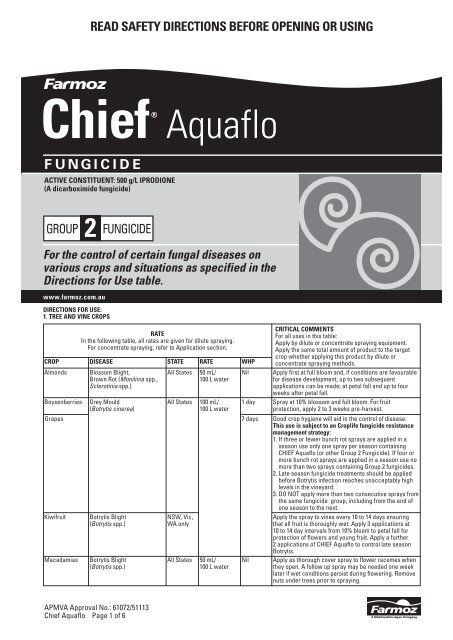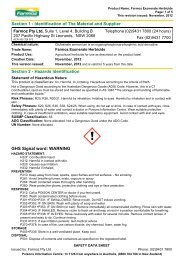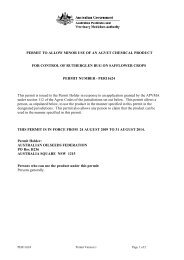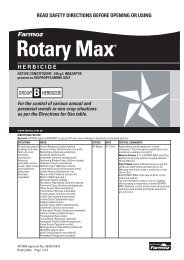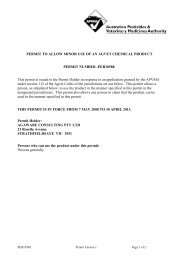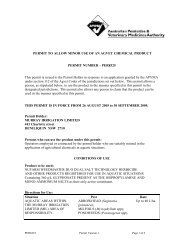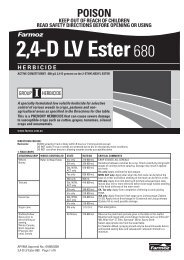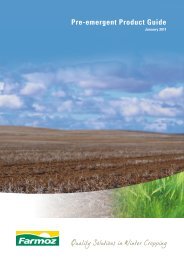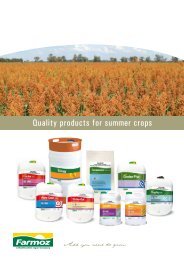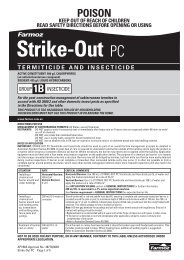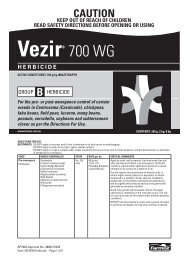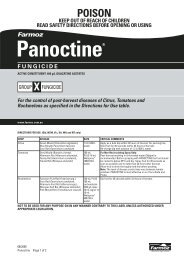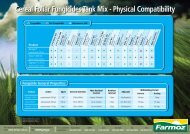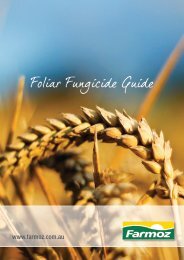View Label - Farmoz
View Label - Farmoz
View Label - Farmoz
You also want an ePaper? Increase the reach of your titles
YUMPU automatically turns print PDFs into web optimized ePapers that Google loves.
For the control of certain fungal diseases on<br />
various crops and situations as specified in the<br />
Directions for Use table.<br />
www.farmoz.com.au<br />
DIRECTIONS FOR USE:<br />
1. TREE AND VINE CROPS<br />
Almonds Blossom Blight,<br />
Brown Rot (Monilinia spp.,<br />
Sclerotinia spp.)<br />
Boysenberries Grey Mould<br />
(Botrytis cinerea)<br />
READ SAFETY DIRECTIONS BEFORE OPENING OR USING<br />
Chief®<br />
FUNGICIDE<br />
ACTIVE CONSTITUENT: 500 g/L IPRODIONE<br />
(A dicarboximide fungicide)<br />
GROUP 2 FUNGICIDE<br />
RATE<br />
In the following table, all rates are given for dilute spraying.<br />
For concentrate spraying, refer to Application section.<br />
CROP DISEASE STATE RATE<br />
APMVA Approval No.: 61072/51113<br />
Chief Aquaflo Page 1 of 6<br />
Aquaflo<br />
All States 50 mL/<br />
100 L water<br />
All States 100 mL/<br />
100 L water<br />
CRITICAL COMMENTS<br />
For all uses in this table:<br />
Apply by dilute or concentrate spraying equipment.<br />
Apply the same total amount of product to the target<br />
crop whether applying this product by dilute or<br />
WHP concentrate spraying methods.<br />
Nil Apply first at full bloom and, if conditions are favourable<br />
for disease development, up to two subsequent<br />
applications can be made; at petal fall and up to four<br />
weeks after petal fall.<br />
1 day Spray at 10% blossom and full bloom. For fruit<br />
protection, apply 2 to 3 weeks pre-harvest.<br />
Grapes 7 days Good crop hygiene will aid in the control of disease.<br />
This use is subject to an Croplife fungicide resistance<br />
management strategy:<br />
1. If three or fewer bunch rot sprays are applied in a<br />
season use only one spray per season containing<br />
CHIEF Aquaflo (or other Group 2 Fungicide). If four or<br />
more bunch rot sprays are applied in a season use no<br />
more than two sprays containing Group 2 fungicides.<br />
2. Late season fungicide treatments should be applied<br />
before Botrytis infection reaches unacceptably high<br />
levels in the vineyard.<br />
3. DO NOT apply more than two consecutive sprays from<br />
the same fungicide group, including from the end of<br />
one season to the next.<br />
Kiwifruit Botrytis Blight<br />
(Botrytis spp.)<br />
Macadamias Botrytis Blight<br />
(Botrytis spp.)<br />
NSW, Vic,<br />
WA only<br />
All States 50 mL/<br />
100 L water<br />
Apply the spray to vines every 10 to 14 days ensuring<br />
that all fruit is thoroughly wet. Apply 3 applications at<br />
10 to 14 day intervals from 10% bloom to petal fall for<br />
protection of flowers and young fruit. Apply a further<br />
2 applications of CHIEF Aquaflo to control late season<br />
Botrytis.<br />
Nil Apply as thorough cover spray to flower racemes when<br />
they open. A follow up spray may be needed one week<br />
later if wet conditions persist during flowering. Remove<br />
nuts under trees prior to spraying.
1. TREE AND VINE CROPS – continued<br />
CROP DISEASE STATE RATE WHP CRITICAL COMMENTS<br />
Mandarins Alternaria Leaf Spot Qld, NT, 100 mL/ Nil Apply to non-bearing trees of Murcott variety monthly<br />
(non-bearing) (Brown Spot)<br />
WA only 100 L water<br />
from first flush in Spring until flushing ceases in the<br />
(Alternaria altenata)<br />
Autumn. Reduce intervals to fortnightly during periods of<br />
wet weather.<br />
Passionfruit Alternata Spot (Brown Spot) Qld, NSW,<br />
7 days This use is subject to an CropLife fungicide resistance<br />
(Alternaria spp.,<br />
NT, WA<br />
management strategy:<br />
Alternaria passiflora) only<br />
1. Maintain a protective cover with protectant fungicide<br />
such as mancozeb.<br />
2. Limit the use of CHIEF Aquaflo to strategic periods, i.e.<br />
before, during and after extended wet periods.<br />
3. Always tank mix CHIEF Aquaflo with a protectant such<br />
as mancozeb.<br />
4. DO NOT apply more than four CHIEF Aquaflo<br />
(or other Group 2 fungicide) sprays in a season.<br />
Raspberries Grey Mould<br />
All States 1 day Spray at 10% blossom and full bloom. For fruit<br />
(Botrytis cinerea)<br />
protection, apply at 2 to 3 weeks pre-harvest.<br />
Stone Fruit: Orchard Spraying<br />
Qld, NSW, 50 to 75 mL/ Nil For control of Blossom Blight, spray at 10% blossom, full<br />
Apricots, Blossom Blight<br />
Vic, Tas, 100 L water<br />
bloom and petal/shuck fall. For control of subsequent<br />
Cherries, (Monilinia fructicola, SA, WA<br />
Brown Rot in fruit, spray at 3 weeks and 1 week<br />
Nectarines, Monilinia laxa),<br />
only<br />
pre-harvest. Use higher rate under severe conditions<br />
Peaches, Brown Rot<br />
of challenge or for single applications of CHIEF Aquaflo<br />
Plums<br />
(Monilinia fructicola,<br />
in the spray program.<br />
Monilinia laxa)<br />
This use is subject to an CropLife fungicide resistance<br />
management strategy:<br />
1. DO NOT apply more than two consecutive sprays of<br />
CHIEF Aquaflo or (other Group 2 Fungicides).<br />
2. A post-harvest treatment should also be counted as<br />
an application.<br />
3. The last Blossom Blight spray and the first pre-harvest<br />
brown rot spray should be regarded as consecutive<br />
applications.<br />
4. The spray program should be considered, and the<br />
strategy applied on a whole orchard basis.<br />
Youngberries Grey Mould<br />
All States 100 mL/ 1 day Spray at 10% blossom and full bloom. For fruit<br />
(Botrytis cinerea)<br />
100 L water<br />
protection, apply at 2 to 3 weeks pre-harvest.<br />
2. FRUIT – POST HARVEST DIPPING<br />
CROP DISEASE STATE RATE WHP CRITICAL COMMENTS<br />
Pome Fruit: Post-harvest Dipping All States 100 mL/ Nil To minimise the development of post-harvest rots handle<br />
Apples, Pears Storage Rots<br />
100 L water<br />
fruit carefully to avoid fruit injury and dip promptly after<br />
(Penicillium spp.)<br />
harvest. Remove any infected fruit from the packing<br />
(Botrytis spp.)<br />
house immediately and destroy. When dipping, allow<br />
(Gloeosporium spp.)<br />
sufficient time to thoroughly wet the fruit. Top up dip<br />
with 100 mL. CHIEF Aquaflo in 100 L of water.<br />
This use is subject to an CropLife fungicide resistance<br />
management strategy:<br />
1. For the last pre-harvest spray, use a fungicide with a<br />
different mode of action to the fungicide planned for<br />
use as a post-harvest treatment.<br />
2. Where alternative fungicide groups are available<br />
rotate to use as many different modes of action as<br />
possible.<br />
3. DO NOT dispose of unused dip solutions as a spray to<br />
crops or orchards.<br />
4. DO NOT dispose of unused dip solutions within or<br />
near the crop or orchard area.<br />
Stone Fruit: Post-harvest Dipping Qld, NSW,<br />
To minimise the development of post-harvest rots handle<br />
Apricots, Brown Rot<br />
Vic, Tas,<br />
fruit carefully to avoid fruit injury and dip promptly after<br />
Cherries, (Monilinia fructicola, SA, WA<br />
harvest. Remove any infected fruit from the packing<br />
Nectarines, Monilinia laxa),<br />
only<br />
house immediately and destroy. When dipping, allow<br />
Peaches, *Transit Rot (Rhizopus spp.)<br />
sufficient time to thoroughly wet the fruit. Top up dip<br />
Plums<br />
with 200 mL CHIEF Aquaflo in 100 L of water. A non-ionic<br />
wetting agent should be added.<br />
*Transit Rot is suppressed at this rate.<br />
This use is subject to an CropLife fungicide resistance<br />
management strategy:<br />
1. For the last pre-harvest spray, use a fungicide with a<br />
different mode of action to the fungicide planned for<br />
use as a post-harvest treatment.<br />
2. Where alternative fungicide groups are available,<br />
rotate to use as many different modes of action as<br />
possible.<br />
3. DO NOT dispose of unused dip solutions as a spray to<br />
crops or orchards.<br />
4. DO NOT dispose of unused dip solutions within or<br />
near the crop or orchard area.<br />
Chief Aquaflo Page 2 of 6
3. BERRIES (SEE TREE AND VINES FOR BOYSENBERRIES, RASBERRIES AND YOUNGBERRIES)<br />
CROP DISEASE STATE RATE WHP CRITICAL COMMENTS<br />
Strawberries Grey Mould<br />
All States 1.0 L/ha where 1 day This use is subject to an CropLife fungicide resistance<br />
(Botrytis cinerea)<br />
spray volume<br />
management strategy:<br />
is less than<br />
1. Apply a program of protectant fungicides during<br />
1000 L/ha or<br />
flowering. If conditions favour disease development<br />
100 mL/100 L<br />
during this period use CHIEF Aquaflo.<br />
water where<br />
2. DO NOT apply more than two successive sprays of<br />
spray volume<br />
equals or<br />
exceeds<br />
1000 L/ha<br />
CHIEF Aquaflo (or other Group 2 Fungicide).<br />
4. VEGETABLES<br />
CROP DISEASE STATE RATE WHP CRITICAL COMMENTS<br />
Brassica Leafy Control of Sclerotinia All States 1 L/ha 7 days Apply as two applications at 14 day intervals when<br />
Vegetables: (Sclerotinia sclerotiorum),<br />
(H, G) conditions favour the disease. Apply using hollow cone<br />
Bok Choy Grey Mould<br />
or flat fan nozzles to give an even and thorough<br />
(Chinese White (Botrytis cinerea),<br />
coverage. Apply in a minimum of 200 L/ha depending on<br />
Cabbage, Alternaria Leaf Spot<br />
crop size and density.<br />
Chinese Chard),<br />
Pak Choy<br />
(Chinese White<br />
Cabbage,<br />
Chinese Chard),<br />
Choi Sum<br />
(Chinese<br />
Flowering<br />
Cabbage),<br />
Gai Lum, Gai<br />
Lan, Kai Lan<br />
(All Chinese<br />
Broccoli),<br />
Kai Choi<br />
(Indian Mustard<br />
Cabbage),<br />
Wong Bok,<br />
Pet Sai,<br />
Hatsukai<br />
(All Chinese<br />
Cabbage),<br />
Mizuna (Mizuna<br />
Greens), Amsoi<br />
(Red Mustard),<br />
Taishona<br />
(Curled<br />
Mustard),<br />
Komatsuma<br />
(Mustard<br />
Spinach),<br />
Tatsoi (Chinese<br />
Flat Cabbage),<br />
Gai Choy, Kai<br />
Choi, Am Soi<br />
(Chinese<br />
Mustard,<br />
Indian Mustard),<br />
Turnip Greens,<br />
Mustard<br />
Greens,<br />
Rutabaga<br />
Greens, Mibuna,<br />
Kale<br />
(Alternaria brassicae)<br />
Celery Sclerotinia Rot (Pink Rot ) All States 1.0 L/ha where 1 day Commence spraying 1 to 2 weeks post-transplanting<br />
(Sclerotinia sclerotiorum)<br />
spray volume<br />
then every 2 to 3 weeks. Use only 5 sprays.<br />
Lettuce Sclerotinia Rot (drop)<br />
(Sclerotinia sclerotiorum,<br />
Sclerotinia minor)<br />
Grey Mould (Botrytis spp.) Tas, WA<br />
only<br />
is less than<br />
1000 L/ha<br />
OR<br />
100 mL/100 L<br />
water where<br />
spray volume<br />
equals or<br />
exceeds<br />
1000 L/ha<br />
7 days Spray should be directed to the stems at ground level<br />
and to the underside of lower leaves.<br />
This use is subject to an CropLife fungicide resistance<br />
management strategy:<br />
1. Apply CHIEF Aquaflo as a seedling drench soon after<br />
emergence.<br />
2. Apply a protectant fungicide as a high volume foliar<br />
spray before planting out, then CHIEF Aquaflo<br />
immediately after planting.<br />
3. Maintain cover with protectant fungicide sprays at<br />
7-10 day intervals.<br />
4. If weather conditions favour Botrytis infection, tank<br />
mix the protectant with CHIEF Aquaflo.<br />
5. DO NOT apply CHIEF Aquaflo (or other Group 2<br />
fungicides) more than 4 times per season, irrespective<br />
of the target disease.<br />
Chief Aquaflo Page 3 of 6
4. VEGETABLES – continued<br />
CROP DISEASE STATE RATE WHP CRITICAL COMMENTS<br />
Potatoes Sclerotinia Rot<br />
All States 500 mL to 1.0 Nil Apply 2 sprays, once immediately before and once<br />
(Sclerotinia sclerotiorum)<br />
L/ha where<br />
immediately after hilling-up. For most effective<br />
spray volume<br />
treatment, concentrate the spray at the base of the<br />
is less than<br />
stems and surrounding soil surface, where the fungus<br />
1000 L/ha<br />
is active. Use the higher rate where disease is severe.<br />
Target Spot (Early Blight)<br />
(Alternaria solani)<br />
OR<br />
50 to 100<br />
mL/100 L water<br />
where spray<br />
volume equals<br />
or exceeds<br />
1000 L/ha<br />
Ensure thorough coverage to the whole plant. Treatment<br />
is generally not required until after flowering. Use the<br />
higher rate where disease is severe.<br />
This use is subject to an CropLife fungicide resistance<br />
management strategy:<br />
1. Limit use of CHIEF Aquaflo to periods when conditions<br />
favour disease development.<br />
2. DO NOT apply more than four CHIEF Aquaflo (or other<br />
Group 2 fungicide) sprays in one season.<br />
3. Apply no more than two consecutive sprays of a<br />
Group 2 fungicide.<br />
Hypocotyl Rot (Black Scurf)<br />
400 mL/<br />
CHIEF Aquaflo will protect emerging shoots from<br />
(Rhizoctonia solani)<br />
tonne seed<br />
Hypocotyl Rot, improving overall germination.<br />
material<br />
CHIEF Aquaflo may also reduce occurrence of Black<br />
Scurf on the harvested potatoes. Ensure good coverage<br />
of seed material and planting furrow. This can be<br />
achieved by applying CHIEF Aquaflo as a fine spray to<br />
the seed at the time of planting using spray equipment<br />
mounted on the planter, and nozzles located at three<br />
points on each planter row to ensure uniform coating of<br />
seed. DO NOT plant into waterlogged soils. A minimum<br />
water volume of 80 L/tonne seed should be used.<br />
Tomatoes Sclerotinia Rot<br />
Qld, NSW, 1.0 L/ha where 7 days Spray at 14 day intervals from transplanting and<br />
(Sclerotinia sclerotiorum) Tas, SA, spray volume<br />
throughout period of disease pressure.<br />
WA only is less than<br />
Grey Mould<br />
All States 1000 L/ha<br />
Commence spraying 3 to 4 weeks after transplanting or<br />
(Botrytis cinerea)<br />
OR<br />
at the onset of disease. Repeat treatment at 14 day<br />
100 mL/100 L<br />
intervals or when conditions favour spread of disease<br />
water where<br />
i.e. at trimming or deleafing.<br />
spray volume<br />
This use is subject to an CropLife fungicide resistance<br />
equals or<br />
management strategy:<br />
exceeds<br />
1. Alternate or tank mix CHIEF Aquaflo with a protectant<br />
1000 L/ha<br />
such as chlorothalonil. Avoid applying two CHIEF<br />
Aquaflo (or other Group 2 fungicide) sprays<br />
in succession, unless tank mixed with a protectant.<br />
2. DO NOT apply more than 4 CHIEF Aquaflo (or other<br />
Group 2 fungicide) sprays in a season.<br />
Target Spot (Early Blight)<br />
(Alternaria Solani)<br />
5. FIELD CROPS<br />
CROP DISEASE STATE RATE WHP CRITICAL COMMENTS<br />
Lucerne Lucerne Leaf Spot<br />
Qld, 250 mL to 500 7 days (G) Spray every 10 to 14 days when cool, damp weather<br />
(Stemphylium botryosum) WA only mL/ha where<br />
favours the disease. Use the higher rate under<br />
spray volume<br />
is less than<br />
conditions of high disease pressure.<br />
Leptosphaerulina Leaf Spot<br />
(Leptosphaerulina trifolii)<br />
1000 L/ha<br />
OR<br />
25 to 50 mL per<br />
100 L water<br />
where spray<br />
volume equals<br />
or exceeds<br />
1000 L/ha<br />
Apply in at least 300 L water/ha every 10 to 14 days<br />
when cool, damp weather favours the disease. Use the<br />
higher rate under conditions of high disease pressure.<br />
Peanuts Sclerotinia Rot<br />
1.0 L/ha 12 days Apply when disease first appears. Repeat if necessary.<br />
(Sclerotinia sclerotiorum,<br />
OR<br />
Use a high volume of water to ensure good coverage of<br />
Sclerotinia minor)<br />
220 mL/100 L<br />
foliage and stem at ground level.<br />
water (spot<br />
DO NOT mix with a foliar fungicide due to the different<br />
application)<br />
target positions on the plant.<br />
Soybeans Black Leaf Blight<br />
(Arkoola nigra)<br />
Chief Aquaflo Page 4 of 6<br />
Qld, NT,<br />
Tas, WA<br />
only<br />
NSW,<br />
WA only<br />
1.0 L/200 to 400<br />
L water per ha<br />
Commence spraying 1 week post-planting. Use<br />
adequate water to give thorough coverage of plants.<br />
Use high volume spray equipment.<br />
This use is subject to an CropLife fungicide resistance<br />
management strategy:<br />
1. Limit the use of CHIEF Aquaflo to periods when<br />
conditions favour disease development.<br />
2. DO NOT apply more than four CHIEF Aquaflo (or other<br />
Group 2 fungicide) sprays in one season. Apply no<br />
more than two consecutive sprays of a Group 2<br />
fungicide.<br />
7 weeks If disease is present on leaves apply an initial spray at<br />
early pod set (pods approximately 5 mm long).<br />
An additional spray 14 days later may be required if wet<br />
seasonal conditions prevail.
6. ORNAMENTALS AND TURF<br />
CROP DISEASE STATE RATE WHP CRITICAL COMMENTS<br />
Ornamentals Botrytis Blight<br />
(Botrytis cinerea)<br />
All States 100 mL/<br />
100 L water<br />
Nil Spray at 14 day intervals commencing when the disease<br />
first becomes apparent and continuing until conditions<br />
no longer favour the disease. Spraying Saintpaulia and<br />
Poinsettia flowers may result in some petal scorch.<br />
Tepid water should be used and wet plants protected<br />
from direct sunlight.<br />
This use is subject to an CropLife fungicide resistance<br />
management strategy:<br />
DO NOT apply more than 2 consecutive sprays of a<br />
Group 2 fungicide.<br />
Recreational<br />
Turf<br />
Brown Patch<br />
(Rhizoctonia solani),<br />
Dollar Spot<br />
(Sclerotinia homoeocarpa)<br />
60 to 90 mL/<br />
10 to 150 L<br />
water/100m2 All States – Curative Program: Repeat treatment after 14 days. Use<br />
the higher rate under conditions of severe disease<br />
pressure.<br />
For Preventative Treatment: Apply as a monthly spray<br />
Brown Patch<br />
(Curvularia spp.)<br />
(Dreschlera spp.)<br />
(Fusarium culmorum)<br />
(Rhizoctonia solani)<br />
Vic only<br />
program.<br />
This use is subject to an CropLife fungicide resistance<br />
management strategy:<br />
DO NOT apply more than two consecutive sprays of<br />
CHIEF Aquaflo (or other Group 2 fungicides), unless<br />
mixed with a protectant fungicide from Group 14, 28, M2,<br />
M3, M4 or M5.<br />
Fusarium Patch<br />
90 mL/<br />
(Fusarium nivale)<br />
10 to 150 L<br />
water/100m<br />
Spring Dead Spot<br />
(Helminthosporium spp.)<br />
(Curvularia spp.)<br />
Vic, WA,<br />
NT only<br />
2<br />
All States For Curative Treatment: Repeat treatment in 14 days.<br />
For Preventative Treatment: Apply as a monthly spray<br />
program.<br />
This use is subject to an CropLife fungicide resistance<br />
management strategy:<br />
DO NOT apply more than two consecutive sprays of<br />
CHIEF Aquaflo (or other Group 2 fungicides), unless<br />
mixed with a protectant fungicide from Group 14, 28, M2,<br />
M3, M4 or M5.<br />
Spring Dead Spot<br />
65 mL/<br />
(Leptosphaeria spp.)*<br />
10 to 150 L<br />
water/100m2 NSW, SA,<br />
For Preventative Treatment only: Apply as a monthly soil<br />
ACT only<br />
drench throughout the year. Water in thoroughly after<br />
application.<br />
* When used in a preventative program this product will<br />
limit the development of Leptosphaeria and improve<br />
the rate of turf recovery.<br />
This use is subject to an CropLife fungicide resistance<br />
management strategy:<br />
DO NOT apply more than two consecutive sprays of<br />
CHIEF Aquaflo (or other Group 2 fungicides), unless<br />
mixed with a protectant fungicide from Group 14, 28, M2,<br />
M3, M4 or M5.<br />
Helminthosporium disease<br />
45 mL/<br />
affecting leaf, crown and<br />
10 to 150 L<br />
roots: (Black and White<br />
water/100m<br />
Helminthosporium Spot:<br />
Bipolaris spp.,<br />
Drechslera spp.,<br />
Exserohilum spp.)<br />
2<br />
All States For Curative Treatment: Apply as a foliar spray and<br />
repeat application after 7 to 14 days. For White Spot<br />
symptoms on couch grass (Cynodon dactylon) only, use<br />
higher water volumes of 100 to 150 L of water per 100m2 Leaf Spot (Dreschlera spp.) 60 mL/<br />
10 to 150 L<br />
water/100m<br />
.<br />
For Preventative Treatment: Apply as a high volume<br />
foliar spray. Repeat applications at monthly intervals<br />
from February to May.<br />
This use is subject to an CropLife fungicide resistance<br />
management strategy:<br />
DO NOT apply more than two consecutive sprays of<br />
CHIEF Aquaflo (or other Group 2 fungicides), unless<br />
mixed with a protectant fungicide from Group 14, 28, M2,<br />
M3, M4 or M5.<br />
2<br />
NOT TO BE USED FOR ANY PURPOSE, OR IN ANY MANNER, CONTRARY TO THIS LABEL UNLESS AUTHORISED UNDER<br />
APPROPRIATE LEGISLATION.<br />
WITHHOLDING PERIODS:<br />
Harvest<br />
ALMONDS, MACADAMIAS, MANDARINS, POME FRUIT, POTATOES, STONE FRUIT:<br />
NOT REQUIRED WHEN USED AS DIRECTED.<br />
BOYSENBERRIES, CELERY, RASPBERRIES, STRAWBERRIES, YOUNGBERRIES:<br />
DO NOT HARVEST FOR 1 DAY AFTER APPLICATION.<br />
BRASSICA LEAFY VEGETABLES, GRAPES, KIWIFRUIT, LETTUCE, TOMATOES AND PASSIONFRUIT:<br />
DO NOT HARVEST FOR 7 DAYS AFTER APPLICATION.<br />
PEANUTS: DO NOT HARVEST FOR 12 DAYS AFTER APPLICATION.<br />
SOYBEANS: DO NOT HARVEST FOR 7 WEEKS AFTER APPLICATION.<br />
Grazing<br />
BRASSICA LEAFY VEGETABLES, LUCERNE:<br />
DO NOT GRAZE OR CUT FOR STOCK FOOD FOR 7 DAYS AFTER APPLICATION.<br />
Chief Aquaflo Page 5 of 6
GENERAL INSTRUCTIONS<br />
FARMOZ CHIEF ® Aquaflo Fungicide is a dicarboximide contact<br />
fungicide with protective and curative action. The active constituent<br />
iprodione inhibits germination of spores and growth of fungal<br />
mycelium. CHIEF Aquaflo is a water based flowable fungicide offering<br />
good crop safety and is non-phytotoxic when used as directed. CHIEF<br />
Aquaflo may be used in orchard spraying and post-harvest dip<br />
applications as directed to control a broad spectrum of fungal<br />
diseases.<br />
FUNGICIDE RESISTANCE WARNING<br />
FARMOZ CHIEF ® Aquaflo Fungicide is a<br />
member of the Dicarboximide group of<br />
fungicides. For fungicide resistance management the product is a<br />
Group 2 fungicide.<br />
Some naturally occurring individual fungi resistant to the product and<br />
other Group 2 fungicides may exist through normal genetic variability<br />
in any fungal population. The resistant individuals can eventually<br />
dominate the fungal population if these fungicides are used repeatedly.<br />
These resistant fungi will not be controlled by this CHIEF Aquaflo or<br />
other Group 2 fungicides, thus resulting in a reduction in efficacy and<br />
possible yield loss.<br />
Since the occurrence of resistant fungi is difficult to detect prior to<br />
use, FARMOZ Pty. Ltd. accepts no liability for any losses that may<br />
result from the failure of this product to control resistant fungi.<br />
MIXING<br />
Note: CHIEF Aquaflo may be unstable in conditions where the pH is 7<br />
or higher. It is therefore essential to check the pH of the spray solution<br />
before adding CHIEF Aquaflo. A suitable registered buffering agent<br />
may have to be added to bring pH down below 7 (eg. SprayBuff # ).<br />
Add the required amount of CHIEF Aquaflo to the spray tank containing<br />
half the required volume of water. Mix thoroughly and make up to the<br />
required volume with water<br />
TURF NUTRITION<br />
This product acts very rapidly and where the turf is of a low nutritional<br />
status, a slight yellowing may be seen. This will be corrected by<br />
nitrogenous fertilizer application. Where possible, it is recommended<br />
that the fertilizer program should precede the fungicide application.<br />
APPLICATION<br />
Good disease control requires even, thorough coverage of the target<br />
area. Application should be made using sufficient water to ensure<br />
thorough coverage.<br />
Tree and Vine Crops<br />
Dilute Spraying<br />
Use a sprayer designed to apply high volumes of water up to the point<br />
of run-off and matched to the crop being sprayed. Set up and operate<br />
the sprayer to achieve even coverage throughout the crop canopy.<br />
Apply sufficient water to cover the crop to the point of run-off. Avoid<br />
excessive run-off. The required water volume may be determined by<br />
applying different test volumes, using different settings on the sprayer,<br />
from industry guidelines or expert advice. Add the amount of product<br />
specified in the Directions For Use table for each 100 L of water. Spray<br />
to the point of run-off. The required dilute spray volume will change<br />
and the sprayer set up and operation may also need to be changed, as<br />
the crop grows.<br />
Concentrate Spraying<br />
Use a sprayer designed and set up for the concentrate spraying (that<br />
is a sprayer which applies water volumes less than those required to<br />
reach the point of run-off) and matched to the crop being sprayed. Set<br />
up and operate the sprayer to achieve even coverage throughout the<br />
crop canopy using your chosen water volume. Determine an<br />
appropriate dilute spray volume (See Dilute Spraying above) for the<br />
crop canopy. This is needed to calculate the concentrate mixing rate.<br />
The mixing rate for concentrate can then be calculated in the following<br />
way:<br />
EXAMPLE ONLY<br />
1. Dilute spray volume as determined above: For example 1500 L/ha.<br />
2. Your chosen concentrate spray volume: For example 500 L/ha.<br />
3. The concentration factor in this example is: 3x (ie 1500 L ÷ 500 L = 3).<br />
4. If the dilute label rate is 10 mL/100 L, then the concentrate rate<br />
becomes 3 x10, that is 30 mL/100 L of concentrate spraying.<br />
The chosen spray volume, amount of product per 100 L of water, and the<br />
sprayer set up and operation may need to be changed as the crop grows.<br />
PACK SIZES: 5 L, 10 L, 20 L<br />
Chief Aquaflo Page 6 of 6<br />
2<br />
GROUP FUNGICIDE<br />
For further information on concentrate spraying, users are advised to<br />
consult relevant industry guidelines, undertake appropriate<br />
competency training and follow industry Best Practices.<br />
EXPORT OF TREATED PRODUCE<br />
Export produce or animals must have appropriate residue tolerance<br />
limits established in the importing countries and any residues must not<br />
exceed the tolerance limit.<br />
COMPATIBILITY<br />
This product may be combined in the spray with: azinphos-ethyl,<br />
Bugmaster # Flowable, calcium chloride, Strike-Out ® , Coppurite,<br />
dimethoate, mancozeb, DPA, endosulfan, fenitrothion, Miti-fol ® ,<br />
maldison, metalaxyl, methomyl, parathion-methyl.<br />
With any mixture, thoroughly agitate immediately before applying. It is<br />
not recommended to mix this product with more than one of the above<br />
chemicals in the tank.<br />
DO NOT tank mix this product with fertilisers.<br />
Mixing CHIEF Aquaflo with Aliette # WG may result in some settling out.<br />
As formulations of other manufacturer’s products are beyond the<br />
control of FARMOZ Pty. Ltd., all mixtures should be tested prior to<br />
mixing commercial quantities.<br />
PROTECTION OF WILDLIFE, FISH, CRUSTACEANS AND<br />
ENVIRONMENT<br />
Toxic to aquatic organisms. DO NOT contaminate streams, rivers or<br />
waterways with chemical or used containers.<br />
STORAGE AND DISPOSAL<br />
KEEP OUT OF REACH OF CHILDREN. Store in the closed, original<br />
container in a cool, well-ventilated area. Protect from frost. DO NOT<br />
store for prolonged periods indirect sunlight.<br />
Triple rinse containers before disposal. Add rinsings to spray tank. DO<br />
NOT dispose of undiluted chemicals on-site. If recycling, replace cap<br />
and return clean containers to recycler or designated collection point.<br />
If not recycling, break, crush, or puncture and deliver empty packaging<br />
to an approved waste management facility. If an approved waste<br />
management facility is not available bury the empty packaging 500 mm<br />
below the surface in a disposal pit specifically marked and set up for<br />
this purpose clear of waterways, desirable vegetation and tree roots,<br />
in compliance with relevant Local, State or Territory government<br />
regulations. DO NOT burn empty containers or product.<br />
SAFETY DIRECTIONS<br />
May irritate the eyes. Avoid contact with eyes and skin. When opening<br />
the container and using the product wear cotton overalls buttoned to<br />
the neck and wrist (or equivalent clothing), elbow-length PVC gloves<br />
and face shield. If product on skin, immediately wash area with soap<br />
and water. After use and before eating, drinking or smoking, wash<br />
hands, arms and face thoroughly with soap and water. After each<br />
day's use, wash gloves, face shield and contaminated clothing.<br />
FIRST AID<br />
If poisoning occurs contact a doctor or Poisons Information Centre.<br />
Phone Australia 131126.<br />
MATERIAL SAFETY DATA SHEET<br />
Additional information is listed in the material safety data sheet<br />
(MSDS). A material safety data sheet for CHIEF Aquaflo is available<br />
from FARMOZ on request. Call Customer Service on (02) 9431 7800.<br />
CONDITIONS OF SALE: The use of FARMOZ CHIEF Aquaflo Fungicide being beyond<br />
the control of the manufacturer, no warranty expressed or implied is given by<br />
FARMOZ Pty. Ltd., regarding its suitability, fitness or efficiency for any purpose for<br />
which it is used by the buyer, whether in accordance with the directions or not and<br />
FARMOZ Pty. Ltd. accepts no responsibility for any consequence whatsoever from the<br />
use of this product.<br />
® Registered trademarks of a Makhteshim-Agan Company<br />
# Other trademarks<br />
NOT A DANGEROUS GOOD ACCORDING TO THE<br />
AUSTRALIAN DANGEROUS GOODS (ADG) CODE.


